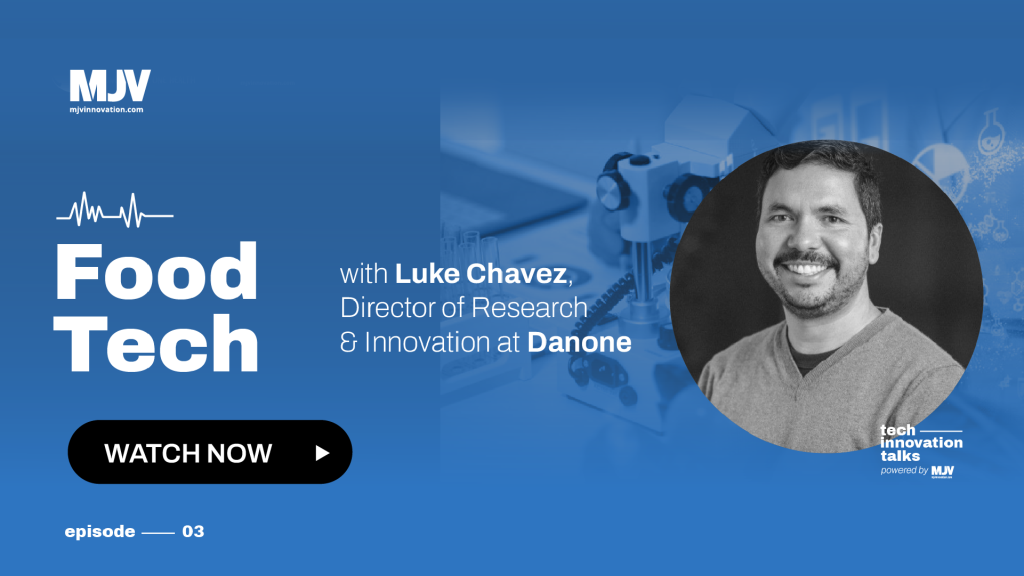You Are What You Eat: An Exclusive Interview with Danone’s Research & Innovation Director
In this installment of Tech Innovation Talks, we sat down with Luke Chavez, then Danone’s Director of Research and Innovation — who recently took over as R&D Director at Sovos Brands — to talk about some of the key trends and context behind food tech.
“Our first line of action is what we sell“. This is how Danone, one of the largest companies in the world, describes its activities in the food sector, and why not CPG & FMCG activities.
Among the company’s objectives, according to its website, is to provide “tastier and healthier food” and to promote “better consumption”, after all, we are what we eat.
In this installment of Tech Innovation Talks, we sat down with Luke Chavez, former Danone’s Director of Research and Innovation — who recently took over as R&D Director at Sovos Brands — to talk about some of the key trends and context behind food tech.
We were joined by MJV’s own Fabricio Astua, Director & Country Head of MJV France, and, as always, our host Paul Sieff Duarte.
The Latest Foodtech Trends Curated By An Expert
Food technology is one of the most change-prone industries in the world, and it’s up to people like Luke to keep innovation alive and well within Danone.
To get us started, we asked Luke to share with us some of the biggest trends that are taking shape within the food industry today:
“There’s a few macro trends that I’ve got my eye on, my team has their eye on. (…) The continued evolution of plant-based and how you can make new plant-based ingredients. (…) those are really the big things we’ve all got our eyes on for 2022.”
Luke Chavez, former Research & Innovation Director at Danone.
You are what you eat: sustainability, food techs & the clean label movement
As climate change begins to reach dangerous levels, people, companies, and governments all over the globe are trying to find alternatives to traditional methods of farming and food production. The largest players in this endeavor are products like the Impossible Burger, which attempt to mimic the taste and consistency of animal-based products through plant-based ingredients.
Fabricio added to this idea by mentioning another trend within the food industry: “I’ve read a lot about the clean label movement, and it’s challenging. How do you source ingredients to clean products? How do you keep products’ main characteristics? And ultimately, how do you communicate this?”
The food industry is unique in the sense that it includes many companies that act as B2B organizations while still producing a product that will eventually make its way into the hands of consumers. While Danone doesn’t sell directly to individuals, they need to make sure that their products are in line with what consumers want. In today’s context, that means products that are more environmentally friendly (what Fabricio mentioned as ‘clean products’).
But the challenges don’t simply stop at making high-quality, ESG-centered products. Another huge issue that plagues the food industry is that customers will naturally make use of products in different ways. Luke framed it like this:
“Say coffee creamer: how do you make sure that it’s going to be the same for one person when there’s someone else who is going to use it in a totally different way?“
Luke Chavez, former Director at Danone.
This challenge might be even more difficult for companies producing products within the realm of coffee and coffee additives. Besides the fact that caffeine is something that consumers take very seriously (almost religiously), it’s something that differs greatly from person to person. Each individual will brew their morning cup of coffee in a different way, with different ingredients in varying concentrations, and even consume the product at different temperatures.
Research is what ensures that Danone is on consumers’ table every day
Luke stated that the real solution to this problem is to conduct as much detailed and personal research as possible. His team will sometimes ask customers to walk them through their daily coffee routines at home, to better understand the intricacies and idiosyncrasies of their end-users. Something that every user-centered company knows should be the top priority for designers and product developers.
It’s these moments that allow Luke and his team to glean insight into the needs of their users. After all, innovation is only possible when you dedicate time, money, and effort to it. And that’s exactly what Luke meant when he talked about discovering ‘what’s going to be next in the future of food.’
But that’s all we’ll share here. If you want to hear the rest of the story, we recommend you check out the full interview on our YouTube channel. Remember, you can also find Tech Innovation Talks on Spotify, Apple, and Google podcasts. Enjoy, and as always, keep innovating!

